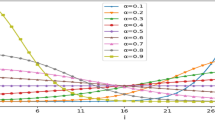Abstract
Query result clustering has attracted considerable attention as a means of providing users with a concise overview of results. However, little research effort has been devoted to organizing the query results for entities which refer to real-world concepts, e.g., people, products, and locations. Entity-level result clustering is more challenging because diverse similarity notions between entities need to be supported in heterogeneous domains, e.g., image resolution is an important feature for cameras, but not for fruits. To address this challenge, we propose a hybrid relationship clustering algorithm, called Hydra, using co-occurrence and numeric features. Algorithm Hydra captures diverse user perceptions from co-occurrence and disambiguates different senses using feature-based similarity. In addition, we extend Hydra into \({\mathsf{Hydra }_\mathsf{gData }}\) with different sources, i.e., entity types and crowdsourcing. Experimental results show that the proposed algorithms achieve effectiveness and efficiency in real-life and synthetic datasets.













Similar content being viewed by others
Notes
These entity types in Table 1 are collected from Freebase (www.freebase.com).
References
Aggarwal, C.C.: A human-computer cooperative system for effective high dimensional clustering. In: KDD (2001)
Aggarwal, C.C., Wolf, J.L., Yu, P.S., Procopiuc, C., Park, J.S.: Fast algorithms for projected clustering. In: SIGMOD (1999)
Aggarwal, C.C., Yu, P.S.: Finding generalized projected clusters in high dimensional spaces. In: SIGMOD (2000)
Agrawal, R., Gehrke, J., Gunopulos, D., Raghavan, P.: Automatic subspace clustering of high-dimensional data for a data mining applications. In: SIGMOD (1998)
Agrawal, R., Gollapudi, S., Halverson, A., Ieong, S.: Diversifying search results. In: WSDM, pp. 5–14 (2009)
Ananthakrishna, R., Chaudhuri, S., Ganti, V.: Eliminating fuzzy duplicates in data warehouses. In: VLDB, pp. 586–597 (2002)
Arasu, A., Götz, M., Kaushik, R.: On active learning of record matching packages. In: SIGMOD Conference, pp. 783–794 (2010)
Basu, S., Bilenko, M., Mooney, R.J.: A probabilistic framework for semi-supervised clustering. In: KDD, pp. 59–68 (2004)
Bazzanella, B., Stoermer, H., Bouquet, P.: Entity type disambiguation in user queries. JIKM 10(3), 209–224 (2011)
Bilenko, M., Basu, S., Sahami, M.: Adaptive product normalization: Using online learning for recored linkage in comparison shopping. In: ICDM (2005)
Bouquet, P., Palpanas, T., Stoermer, H., Vignolo, M.: A conceptual model for a web-scale entity name system. In: ASWC, pp. 46–60 (2009)
Carterette, B., Chandar, P.: Probabilistic models of ranking novel documents for faceted topic retrieval. In: CIKM, pp. 1287–1296 (2009)
Cheng, C.-H., Fu, A.W., Zhang, Y.: Entropy-based subspace clustering for mining numerical data. In: KDD (1999)
Cheng, D., Kannan, R., Vempala, S., Wang, G.: A divide-merge methodology for clustering. In: TODS (2005)
Chierichetti, F., Kumar, R., Pandey, S., Vassilvitskii, S.: Finding the jaccard median. In: SODA, pp. 293–311 (2010)
Cohen, W.W.: Integration of heterogeneous databases without common domains using queries based on textual similarity. In: SIGMOD, pp. 201–212 (1998)
Cui, Y., Hasler, N., Thormählen, T., Seidel, H.-P.: Scale invariant feature transform with irregular orientation histogram binning. In: ICIAR, pp. 258–267 (2009)
Doan, A., Ramakrishnan, R., Halevy, A.Y.: Crowdsourcing systems on the world-wide web. Commun. ACM 54(4), 86–96 (2011)
Franklin, M.J., Kossmann, D., Kraska, T., Ramesh, S., Xin, R.: CrowdDB: answering queries with crowdsourcing. In: SIGMOD, pp. 61–72 (2011)
Goil, S., Nagesh, H., Choudhary, A.: Mafia: efficient and scalable subspace clustering for very large data sets. Technical Report, Northwesthen University (1999)
Gomes, R., Welinder, P., Krause, A., Perona, P.: Crowdclustering. In: NIPS, pp. 558–566 (2011)
Hearst, M.A., Pedersen, J.O.: Re-examining the cluster hypothesis: Scatter/Gather on retrieval results. In: SIGIR (1996)
Jain, A., Pennacchiotti, M.: Open entity extraction from web search query logs. In: COLING, pp. 510–518 (2010)
Jang, M., Park, J.-W., Hwang, S.: Predictive mining of comparable entities from the web. In: AAAI (2012)
Ji, X., Xu, W., Zhu, S.: Document clustering with prior knowledge. In: SIGIR (2006)
Jindal, N., Liu, B.: Identifying comparative sentences in text documents. In: SIGIR, pp. 244–251 (2006)
Lee, J., Hwang, S., Nie, Z., Wen, J.-R.: Query result clustering for object-level search. In: KDD, pp. 1205–1214 (2009)
Lee, J., Hwang, S., Nie, Z., Wen, J.-R.: Navigation system for product search. In: ICDE, pp. 1113–1116 (2010)
Lee, T., Wang, Z., Wang, H., Hwang, S.: Web scale taxonomy cleansing. PVLDB 4(12), 1295–1306 (2011)
Li, S., Lin, C.-Y., Song, Y.-I., Li, Z.: Comparable entity mining from comparative questions. In: ACL, pp. 650–658 (2010)
Liu, Y., Li, W., Lin, Y., Jing, L.: Spectral geometry for simultaneously clustering and ranking query search results. In: SIGIR (2008)
Marcus, A., Wu, E., Madden, S., Miller, R.C.: Crowdsourced databases: Query processing with people. In: CIDR, pp. 211–214 (2011)
Mecca, G., Raunich, S., Pappalardo, A.: A new algorithm for clustering search results. Data Knowl. Eng. 62(3), 504–522 (2007)
Nie, Z., Ma, Y., Shi, S., Wen, J.-R., Ma, W.-Y.: Web object retrieval. In: WWW (2007)
Nie, Z., Wen, J.-R., Ma, W.-Y.: Object-level vertical search. In: CIDR (2007)
Nie, Z., Wen, J.-R., Ma, W.-Y.: Statistical entity extraction from the web. Proc. IEEE 100(9), 2675–2687 (2012)
Nie, Z., Zhang, Y., Wen, J.-R., Ma, W.-Y.: Object-level ranking: bringing order to web objects. In: WWW (2005)
Parameswaran, A.G., Polyzotis, N.: Answering queries using humans, algorithms and databases. In: CIDR, pp. 160–166 (2011)
Parsons, L., Haque, E., Liu, H.: Subspace clustering for high dimensional data: a review. SIGKDD Newsletter 6(1), 90–105 (2004)
Patrikainen, A., Melia, M.: Comparing subspace clusterings. TKDE 18(7), 902–916 (2006)
Radlinski, F., Dumais, S.T.: Improving personalized web search using result diversification. In: SIGIR, pp. 691–692 (2006)
Scripps, J., Tan, P.-N.: Clustering in the presence of bridge-nodes. In: SDM (2006)
Selke, J., Lofi, C., Balke, W.-T.: Pushing the boundaries of crowd-enabled databases with query-driven schema expansion. PVLDB 5(6), 538–549 (2012)
Song, Y., Wang, H., Wang, Z., Li, H., Chen, W.: Short text conceptualization using a probabilistic knowledgebase. In: IJCAI, pp. 2330–2336 (2011)
Wagstaff, K., Cardie, C., Rogers, S., Schroedl, S.: Conttrainted k-means clustering with background knowledge. In: ICML (2001)
Wang, J., Kraska, T., Franklin, M.J., Feng, J.: CrowdER: crowdsourcing entity resolution. PVLDB 5(11), 1483–1494 (2012)
Wang, X., Zhai, C.: Learn from web search logs to organize search results. In: SIGIR (2007)
Wang, X.-J., Ma, W.-Y., He, Q.-C., Li, X.: Grouping web image search result. In: ACM Multimedia, pp. 436–439 (2004)
Whang, S.E., Benjelloun, O., Garcia-Molina, H.: Generic entity resolution with negative rules. VLDB J. 18(6), 1261–1277 (2009)
Whang, S.E., Lofgren, P., Garcia-Molina, H.: Question selection for crowd entity resolution. In: PVLDB (2013)
Woo, K.-G., Lee, J.-H., Kim, M.-H., Lee, Y.-J.: FINDIT: a fast intelligent subspace clusteing algorithm using diemsnion voting. Inform. Softw. Technol. 46(4), 255–271 (2004)
Xu, W., Liu, X., Gong, Y.: Document clustering based on non-negative matrix factorization. In: SIGIR (2003)
Yip, K.Y., Cheung, D.W., Ng, M.K.: HARP: A practical projected clustering algorithm. TKDE 16(11), 1387–1397 (2004)
Yip, K.Y., Cheung, D.W., Ng, M.K.: On discovery of extremely low-dimensional clusters using semi-supervised projected clustering. In: ICDE (2005)
Zamir, O., Etzioni, O.: Web document clustering: a feasibility demonstration. In: SIGIR (1998)
Zeng, H.-J., He, Q.-C., Chen, Z., Ma, W.-Y., Ma, J.: Learning to cluster web search results. In: SIGIR (2004)
Zhu, X., Ghahramani, Z., Lafferty, J.D.: Semi-supervised learning using gaussian fields and harmonic functions. In: ICML, pp. 912–919 (2003)
Acknowledgments
This research was supported by the Ministry of Knowledge Economy (MKE), Korea and Microsoft Research, under IT/SW Creative research program supervised by the NIPA (National IT Industry Promotion Agency). (NIPA-2012-H0503-12-1036).
Author information
Authors and Affiliations
Corresponding author
Rights and permissions
About this article
Cite this article
Lee, J., Cho, H., Park, JW. et al. Hybrid entity clustering using crowds and data. The VLDB Journal 22, 711–726 (2013). https://doi.org/10.1007/s00778-013-0328-8
Received:
Revised:
Accepted:
Published:
Issue Date:
DOI: https://doi.org/10.1007/s00778-013-0328-8




